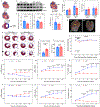A calcineurin-Hoxb13 axis regulates growth mode of mammalian cardiomyocytes
- PMID: 32499640
- PMCID: PMC7670845
- DOI: 10.1038/s41586-020-2228-6
A calcineurin-Hoxb13 axis regulates growth mode of mammalian cardiomyocytes
Abstract
A major factor in the progression to heart failure in humans is the inability of the adult heart to repair itself after injury. We recently demonstrated that the early postnatal mammalian heart is capable of regeneration following injury through proliferation of preexisting cardiomyocytes1,2 and that Meis1, a three amino acid loop extension (TALE) family homeodomain transcription factor, translocates to cardiomyocyte nuclei shortly after birth and mediates postnatal cell cycle arrest3. Here we report that Hoxb13 acts as a cofactor of Meis1 in postnatal cardiomyocytes. Cardiomyocyte-specific deletion of Hoxb13 can extend the postnatal window of cardiomyocyte proliferation and reactivate the cardiomyocyte cell cycle in the adult heart. Moreover, adult Meis1-Hoxb13 double-knockout hearts display widespread cardiomyocyte mitosis, sarcomere disassembly and improved left ventricular systolic function following myocardial infarction, as demonstrated by echocardiography and magnetic resonance imaging. Chromatin immunoprecipitation with sequencing demonstrates that Meis1 and Hoxb13 act cooperatively to regulate cardiomyocyte maturation and cell cycle. Finally, we show that the calcium-activated protein phosphatase calcineurin dephosphorylates Hoxb13 at serine-204, resulting in its nuclear localization and cell cycle arrest. These results demonstrate that Meis1 and Hoxb13 act cooperatively to regulate cardiomyocyte maturation and proliferation and provide mechanistic insights into the link between hyperplastic and hypertrophic growth of cardiomyocytes.
Conflict of interest statement
COMPETING INTEREST DECLARATION
The authors declare no competing interests.
Figures













References
-
- Soonpaa MH & Field LJ Assessment of cardiomyocyte DNA synthesis in normal and injured adult mouse hearts. Am J Physiol 272, H220–226 (1997). - PubMed
Publication types
MeSH terms
Substances
Grants and funding
- R35 GM136243/GM/NIGMS NIH HHS/United States
- R01 HL147276/HL/NHLBI NIH HHS/United States
- R01 GM119336/GM/NIGMS NIH HHS/United States
- R01 HL126012/HL/NHLBI NIH HHS/United States
- R01 HL115275/HL/NHLBI NIH HHS/United States
- S10 OD023552/OD/NIH HHS/United States
- R01 HL131778/HL/NHLBI NIH HHS/United States
- R01 HL128215/HL/NHLBI NIH HHS/United States
- T32 HL125247/HL/NHLBI NIH HHS/United States
- R01 HD101006/HD/NICHD NIH HHS/United States
- P50 HD087351/HD/NICHD NIH HHS/United States
- R01 HL120732/HL/NHLBI NIH HHS/United States
- U54 HD087351/HD/NICHD NIH HHS/United States
- R01 HL072016/HL/NHLBI NIH HHS/United States
LinkOut - more resources
Full Text Sources
Molecular Biology Databases
Research Materials

